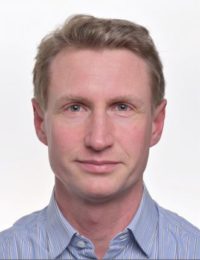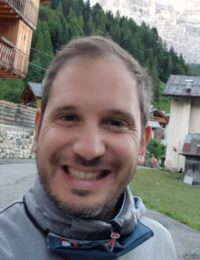Keynote Lecture #1
Operational modal analysis and structural health monitoring with fiber-optic strain sensors

Edwin Reynders
Associate Professor, Department of Civil Engineering, Faculty of Engineering Science, KU Leuven
Edwin Reynders is an Associate Professor at the Department of Civil Engineering of the University of Leuven (KU Leuven), Belgium. In 2009, he received his PhD in Engineering Science from KU Leuven and the Best PhD Award in mechanics from the Royal Academies of Belgium. He then became a Postdoctoral Fellow of the Research Foundation – Flanders (FWO) at KU Leuven and the University of Cambridge, before joining KU Leuven again as an Assistant Professor in 2014. From 2017 until recently, he has been a Starting Grant holder of the European Research Council (ERC). His research expertise is in structural mechanics and building acoustics, and current research interests include numerical and experimental assessment of sound insulation, signal processing and system identification, and structural health monitoring.
https://perswww.kuleuven.be/edwin_reynders
Abstract:
Dynamic monitoring of civil structures based on operational modal analysis from strain data is both promising and challenging. It is promising because the modal characteristics that can be identified from strain time signals comprise both natural frequencies, which are very sensitive to overall structural stiffness changes, and strain mode shapes, which are very sensitive to local stiffness changes in the neighborhood of the sensor locations. It is challenging because the operational dynamic strain levels in large civil structures typically have a very low amplitude, such that both conventional strain sensing systems based on strain gauges and most more recent fiber-optics based strain sensing systems cannot capture the strain signals with sufficient accuracy. Recently, it was demonstrated that vibration-based structural health monitoring of civil infrastructure based on strain data is feasible when fiber-optic Bragg grating sensors are employed in combination with a wavelength sweep interrogation technique and with a robust system identification approach. Three different steel railway bridges have been instrumented and their natural frequencies and strain mode shapes have been monitored for over a year. One of these bridges was due to be replaced, such that low-level artificial damage, in the form of saw cuts simulating fatigue cracks, could be applied. The influence of these local cracks on the strain mode shapes could be clearly identified, while their influence on the natural frequencies remained within the measurement uncertainty. Furthermore, the influence of temperature variations and of an overall retrofit that occurred on one of the monitored bridges was investigated in detail. It was found that such overall effects have a clear influence on the natural frequencies but usually they do not have a noticeable influence on the strain mode shapes. Both features therefore complement each other very well.
Keynote Lecture #2
Advancing Structural Health Monitoring: Embracing a Territorial Perspective

Filippo Ubertini 1,2
1 Department of Civil and Environmental Engineering, University of Perugia, Italy
2 FABRE Consortium, Italy
Dr. Filippo Ubertini is a Full Professor of Structural Design at the Department of Civil and Environmental Engineering of the University of Perugia, Italy, teaching “Structural Analysis and Design” and “Earthquake Engineering”. Dr. Ubertini also serves as the coordinator of the International PhD Program in Civil and Environmental Engineering at the same University.
Having graduated cum laude in Civil Engineering from the University of Perugia in 2005, Dr. Ubertini went on to earn his PhD in Civil Engineering from the University of Pavia in 2009. In 2008, he further enriched his academic experience as a visiting scholar at Columbia University. Throughout his career, he has authored over 150 papers published in highly impactful international journals.
Dr. Ubertini’s research primarily revolves around the area of structural health monitoring, focusing particularly on vibration-based methods, smart materials, and their applications in bridge engineering, historic structures, and earthquake engineering. His expertise has led him to serve on the editorial board of renowned journals like Mechanical Systems and Signal Processing, in addition to contributing to various other international journals. He has also been a member of the scientific committees of several prestigious international conferences.
As Vice-President of the Italian “FABRE” Consortium, Dr. Ubertini spearheads national research on multilevel risk classification and monitoring of civil infrastructures. The consortium has secured substantial multimillion funding in recent years under his co-leadership. Dr. Ubertini has served as Principal Investigator for numerous international and national research projects and has been invited as a plenary/semi-plenary/keynote speaker at renowned international conferences, including Eurodyn 2020 and CBPAT 2020. He has received the award of the Italian Association for Wind Engineering in 2010, and Best Paper Awards at EVACES 2011 and IOMAC 2019.
Abstract:
Many western countries, including Italy, face a significant challenge in quantifying and ensuring the safety of their built heritage and infrastructure network. This challenge is particularly focused on ageing bridges, tunnels, dams, power plants and historic buildings that are exposed to various hazards. In Italy, there is a strong societal awareness regarding the issue of ageing bridges, which has intensified following the tragic collapse of the Morandi bridge in Genoa in 2018. Additionally, recent strong earthquakes, such as the Central Italy seismic sequence from 2016 to 2017, have once again highlighted the importance of preserving built heritage.
Structural Health Monitoring (SHM) can play a crucial role in supporting risk-informed decisions in the face of multiple hazards. However, a paradigm shift is necessary, where SHM is not viewed solely as a strategy for assessing the performance of individual structures, such as a single bridge or building, but rather as a method for understanding the conditions of multiple built assets within a network. This approach can effectively address the chronic lack of labeled data related to damaged conditions in the Civil Engineering community. By employing transfer learning strategies, algorithms can learn to recognize damage in one structure and utilize this knowledge to enhance damage identification capabilities across different structures.
Similarly, emerging SHM approaches suggest the adoption of centralized data analysis, which involves gathering information from numerous structures to establish territorial SHM platforms. This method, although still in its early stages, holds promise. The talk will delve into this emerging topic by showcasing recent research conducted at the University of Perugia in Italy. The focus will be on vibration-based methods, utilizing data science and operational modal analysis tools. Transfer learning and Bayesian inference will be explored for model selection, along with other territorial SHM approaches such as satellite radar interferometry.
Linkedin https://www.linkedin.com/in/filippo-ubertini-3253701ba/
Researchgate https://www.researchgate.net/profile/Filippo-Ubertini?ev=hdr_xprf
Facebook https://www.facebook.com/filippo.ubertini/
Webpage https://www.unipg.it/personale/filippo.ubertini/en/